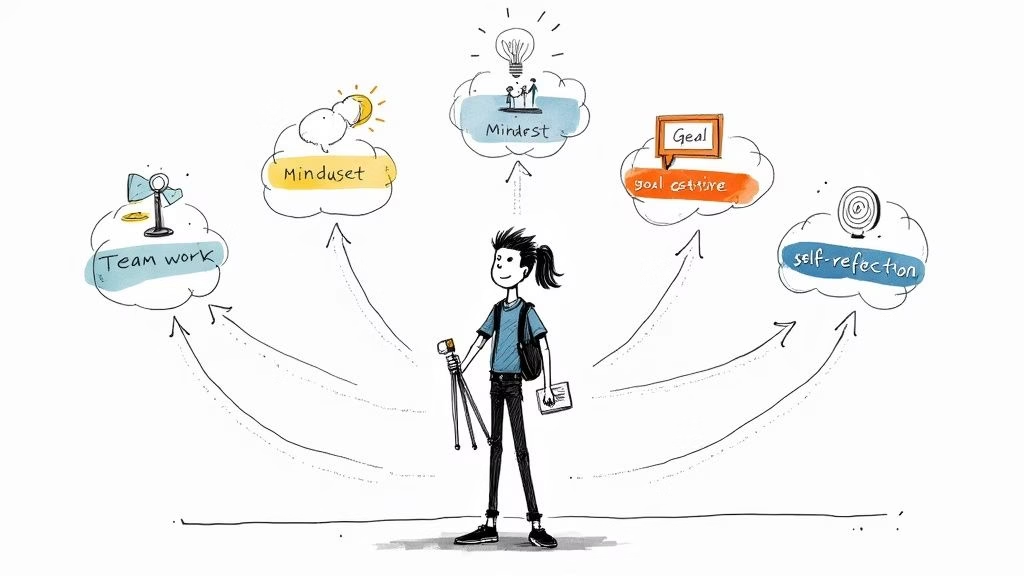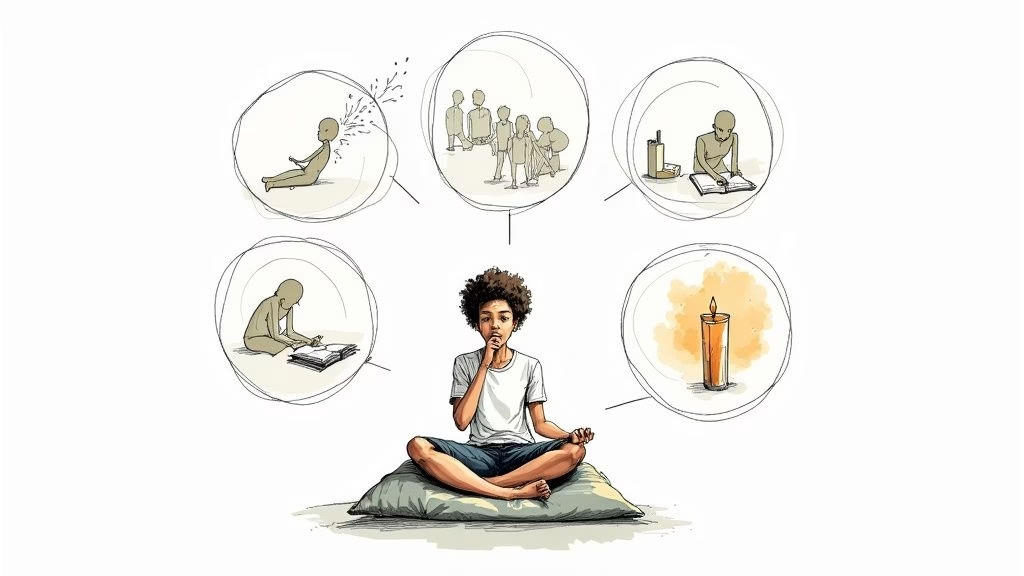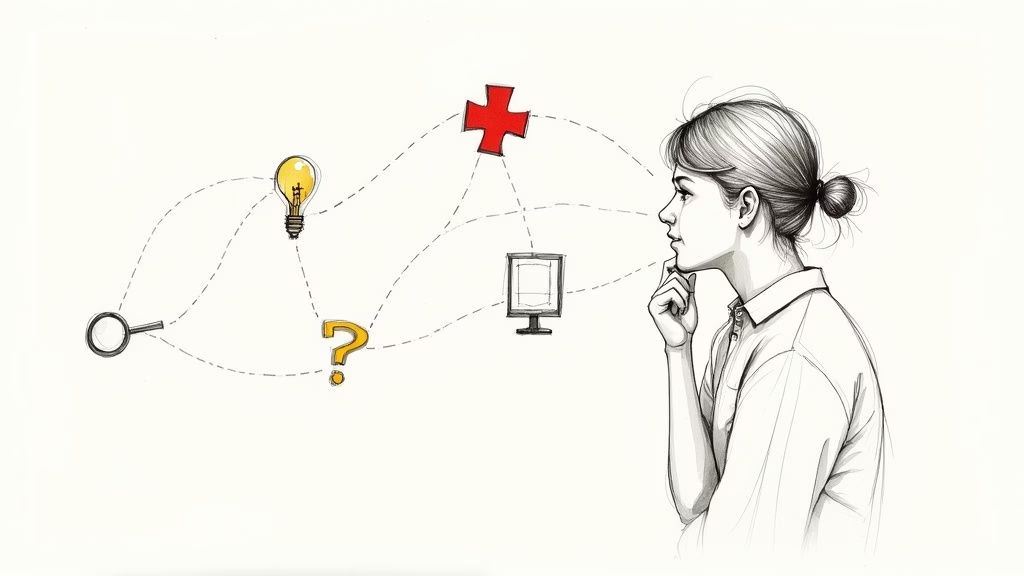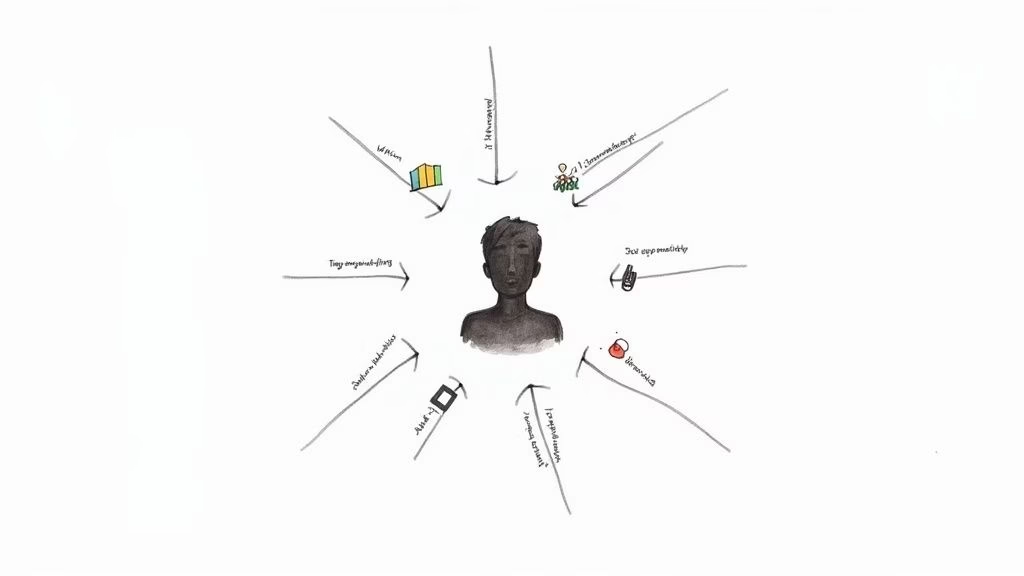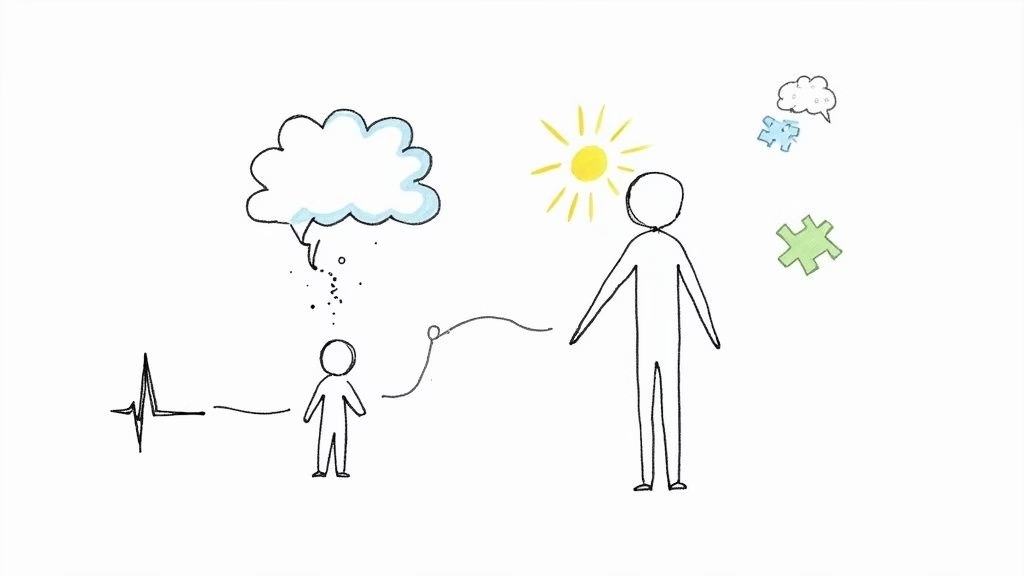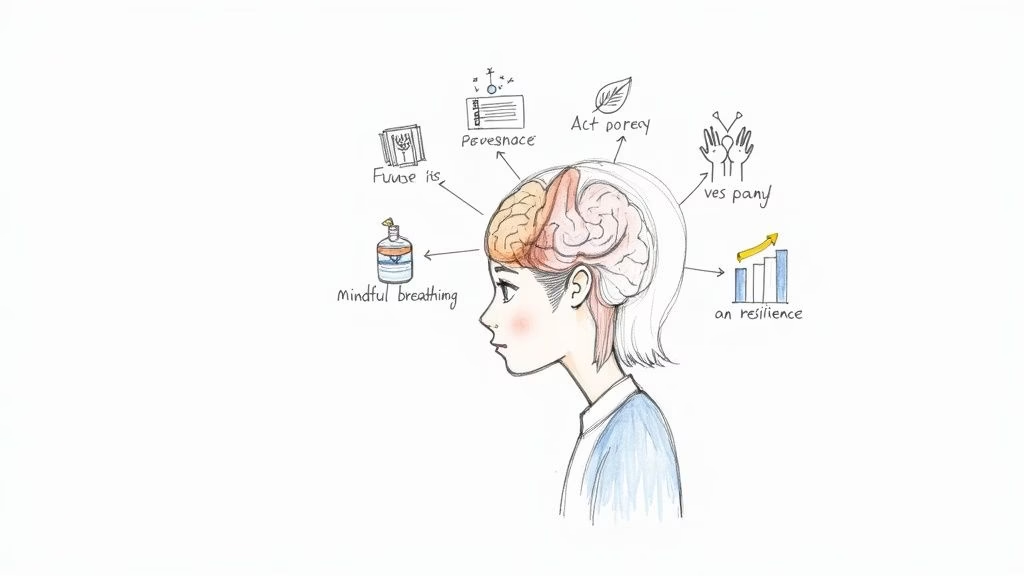Let’s be honest: effective college planning for high school students isn’t about a panicked scramble during senior year. That’s a recipe for stress and burnout. The real journey is a gradual one, built over four years of intentional growth. It’s about weaving together academics, personal interests, and well-being so the application process feels like a natural next step, not a final exam.
Building Your Foundation for College Success
Think of college planning as a marathon, not a sprint. The race starts the moment you walk through the doors of your high school. The secret isn't to do everything at once, but to focus on building a strong foundation. This means prioritizing academics, personal growth, and, just as importantly, mental health.
When you approach it this way, you create a sustainable path that avoids exhaustion. Your application then becomes a genuine reflection of who you’ve become, not just a list of things you did under pressure.
To help you visualize this journey, I've put together a simple timeline outlining key milestones. It’s designed to keep you on track without feeling completely overwhelmed.
A Practical High School College Planning Timeline
This simplified timeline outlines key college planning tasks for each year of high school to ensure you stay on track without feeling overwhelmed.
| High School Year | Academic Focus | Extracurricular and Personal Growth | Testing and Financials |
|---|---|---|---|
| Freshman (9th) | Build strong study habits. Explore interests and challenging courses. | Try new clubs and activities. Focus on discovering passions. | Get familiar with college costs. Start a 529 plan if you haven't. |
| Sophomore (10th) | Deepen academic interests. Take on leadership roles in classes or projects. | Commit to 2-3 key activities. Look for leadership opportunities. | Take the PSAT/NMSQT for practice. Begin scholarship searches. |
| Junior (11th) | Take the most challenging courses you can handle. Build relationships with teachers for recommendations. | Continue leadership roles. Consider a summer program or job in a field of interest. | Prepare for and take the SAT/ACT. Explore financial aid options (FAFSA). |
| Senior (12th) | Maintain strong grades. Finalize college list and application essays. | Showcase long-term commitment and impact in your activities. | Finalize FAFSA and CSS Profile. Compare financial aid offers. |
Each year builds on the last, moving you from exploration and discovery in 9th grade to focused action and decision-making in 12th grade.
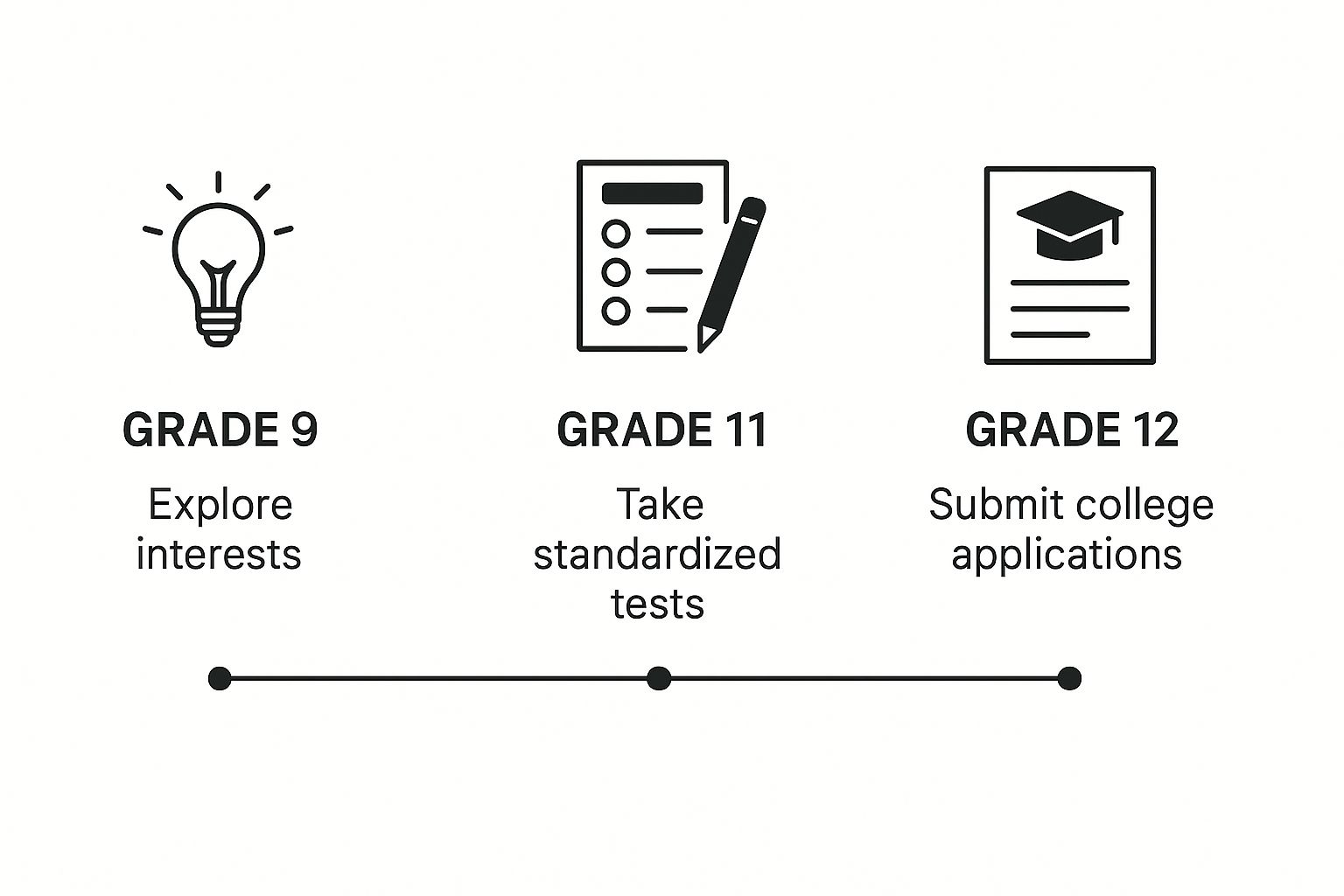
Nurturing Motivation and Good Habits
The single most important part of early planning? Developing solid academic habits. Good grades in freshman year set a powerful tone. Trust me, it’s far easier to maintain a strong GPA than to try and dig yourself out of a hole later.
Parenting Tip: This is your time to be a coach, not a manager. Help your teen design a dedicated study space. Talk openly about time management and how to beat procrastination before it becomes a chronic habit. When you see them struggling with motivation, understand it's often a sign of feeling overwhelmed, not laziness. Instead of asking, "Why aren't you studying?" try, "It looks like getting started is tough. What's one small thing we could tackle together for just 15 minutes?"
But it’s not just about the numbers on a report card. It’s about sparking genuine intellectual curiosity. Encourage your student to connect with their teachers and ask for help when they need it. These small acts build self-advocacy—a skill that’s absolutely essential for thriving in college.
Supporting Your Teen’s Mental Health and Well-being
The pressure cooker of college planning can take a serious toll on a teen's mental health. As a parent, you have a huge role to play in creating a supportive home where well-being comes first. Check in regularly—not just about grades, but about their social life, stress levels, and passions outside of school.
Motivation disappears when a student feels overwhelmed. It’s a fact. Thankfully, there are great resources out there. The Jed Foundation provides fantastic guides for teens on managing their emotional health. Mindfulness apps like Calm or Headspace can also be game-changers for managing anxiety. For immediate support, services like the Crisis Text Line are invaluable. Introducing these tools early helps build the resilience they’ll need for the more demanding years to come.
Our detailed guide on college prep for high school students offers even more strategies for navigating this journey with less stress.
It also helps to keep the bigger picture in mind. Recently, about 19.3 million students enrolled in U.S. colleges, an 8.43% drop from the 2010 peak. The rate of high school graduates immediately enrolling in college has also fallen to 62%. What does this mean? Students are exploring more options than ever, which helps dial down the pressure to follow a single, traditional path.
Finding Colleges That Are the Right Fit for You
With thousands of colleges out there, the search can feel like trying to find one specific book in a massive library without a catalog. The key isn't to just chase the big names or top rankings; it's about finding a place that truly clicks with your academic goals, your personality, and what you want your life to look like for the next four years.
This part of the journey is as much about self-discovery as it is about research.

Before you even start looking at schools, you need to look inward. Start by making a list of what actually matters to you. Do you see yourself thriving in small, discussion-based classes? Or do you prefer the energy of a large lecture hall where you can absorb information more anonymously? Are you a city person who needs a bustling campus, or someone who craves a quiet, self-contained community?
This initial brainstorm is your compass. It will guide your research and keep you from getting distracted by schools that look great on paper but just wouldn't be a good fit in reality.
Building a Balanced College List
A smart college list isn't just a list of dream schools; it's a balanced one. You want a healthy mix of schools that fall into three main categories. This strategy gives you options, helps manage expectations, and ultimately sets you up for a successful admissions season.
- Likely (or Safety) Schools: These are colleges where your academic profile—your GPA, test scores, and coursework—is comfortably above the average for admitted students. The key here is that you should feel confident about your chances of getting in and be genuinely happy to attend.
- Target (or Match) Schools: This is the core of your list. At these schools, your stats line up pretty well with the average admitted student. Admission is realistic, but it's certainly not a sure thing.
- Reach (or Aspirational) Schools: These are your stretch schools. Maybe your profile is slightly below their typical range, or the school is just incredibly selective for everyone (think Ivy League or similar). It's a long shot, but one you're excited to take.
Parenting Tip: This is a crucial time to offer support without adding pressure. Help your teen research schools in all three categories, but let them take the lead. It's also important to frame "likely" schools correctly—they aren't consolation prizes, but fantastic institutions where your child can truly shine.
Research Beyond the Brochure
Once you have a rough list, it's time to dig in. You have to go beyond the glossy brochures and polished official websites to get a real feel for a place.
The goal isn't just to find a school you can get into, but a community where you can thrive. A school's culture, support systems, and location are just as important as its academic reputation.
Virtual tours have become incredibly sophisticated and are a great way to start. Follow the schools you're interested in on social media to see unfiltered, day-to-day student life.
More importantly, think about how location might shape your experience. Regional trends can tell you a lot about campus dynamics and even enrollment patterns. For example, recent data showed that all major U.S. regions saw a bump in spring enrollment, with the South leading at a 4% year-over-year increase. States like Georgia and North Carolina saw even bigger jumps of 5.3% and 4.7%, respectively, often driven by their public and community colleges.
You can dig into more of these college attendance patterns on Higher Ed Dive. This kind of data can give you clues about where growth is happening and where new opportunities might be popping up.
Crafting Your Application and Navigating Financial Aid
This is it. This is where all the self-discovery, hard work, and late-night study sessions finally come together. Your college application is so much more than a list of your grades and activities—it's your chance to tell your story. Think of it as the grand finale of high school, a snapshot that shows admissions officers not just what you've accomplished, but who you are becoming.

The personal essay is the heart of it all. This isn't the time to simply rehash your resume. Admissions officers are looking for vulnerability, reflection, and realness. They want to hear a story that reveals something meaningful about your character, your values, or a moment that fundamentally shifted your perspective.
Assembling the Key Pieces
Beyond the essay, there are a few other critical components that need your attention. Getting these right is a massive part of successful college planning for high school students.
- The Common App: This will become your command center for applying to hundreds of colleges. Get familiar with it early. My advice? Knock out the basic sections during the summer before senior year. It will save you a world of stress when deadlines start creeping up.
- Letters of Recommendation: Don’t put this off. You should be asking teachers at the end of your junior year—teachers who know you as more than just a name on a roster. Give them a "brag sheet" with your resume, a reminder of your work in their class, and a little about your future goals. It helps them write a much stronger, more personal letter.
- Application Deadlines: Get clear on the different types: Early Decision (which is binding), Early Action (non-binding), and Regular Decision. Your strategy here should match how prepared you are and how confident you feel about your number-one school.
Parenting Tip: Your job is to be the support crew—the proofreader and deadline manager. Read essays for typos, but please, resist the urge to rewrite them in your own voice. Help your teen build a shared calendar with every single application and financial aid deadline. It’s a lifesaver.
Demystifying Financial Aid
The whole financial aid process can feel like a tangled mess, but it’s a lot less scary when you tackle it piece by piece. The two forms you absolutely need to know are the FAFSA (Free Application for Federal Student Aid) and the CSS Profile, which many private colleges use to award their own institutional aid.
Financial aid isn't just for low-income families. So many middle-class families qualify for some type of assistance. You have to fill out the FAFSA. Don't leave money on the table because you assumed you wouldn't qualify.
Let’s break down the main types of aid you'll encounter:
- Scholarships and Grants: This is the best kind of money—the kind you don't have to pay back. Scholarships are usually based on merit (think academics, sports, or the arts), while grants are more often based on financial need.
- Loans: This is money you borrow and will have to repay with interest. As a rule, federal loans have much better terms and protections than private loans.
While your GPA is the foundation, strong standardized test scores can unlock some serious merit-based scholarships. For any student looking to give themselves a better shot, it’s worth digging into strategies on how to improve SAT scores. Even a small jump in your score can make a huge difference in your financial aid package and make college much more affordable.
A Parent's Guide to Supporting Your Teen
Your role in the college planning process is a delicate one. It’s easy to slip into project manager mode, but what your teen really needs is a coach—someone in their corner, not someone hovering over their shoulder. This is a minefield of pressure for them, and finding that sweet spot between helping and taking over is the key to keeping your relationship strong.
It all starts with trust. Instead of asking, “Did you finish your applications?” try shifting your language to something like, “How are you feeling about the college search?” It’s a small change, but it cracks the door open for a real conversation about their fears, their excitement, and the stress that’s weighing on them.
Building Independence and Well-being
A huge part of this journey is preparing them for life after they leave your home. This isn't just about getting into college; it's about getting them ready to thrive there. That means intentionally fostering independence now.
- Encourage Self-Advocacy: Let them be the one to email an admissions counselor or schedule a campus tour. These small acts build immense confidence.
- Teach Real-Life Skills: Show them how to do laundry, manage a simple budget, or cook a few basic meals. Seriously. You’d be surprised how much anxiety this prevents down the road.
- Respect Their Rhythm: Every student works at a different pace. Gentle reminders are one thing, but constant nagging is a surefire way to trigger procrastination and resentment.
The goal is to empower them, not to do the work for them. When a teenager feels a true sense of ownership over this process, their motivation sky-rockets because the goals finally feel like their own.
Effective goal-setting is a skill that can completely change how your teen sees this massive undertaking. Our guide on goal setting for teenagers offers some practical ways to help them break down big, scary objectives into small, manageable steps, which makes everything feel less overwhelming.
Navigating Motivation and Mental Health
Let’s be real: procrastination and a lack of motivation are rarely about laziness. More often than not, they’re just symptoms of anxiety. Your teen is likely feeling completely overwhelmed by the pressure to succeed.
The numbers don't lie. In a recent year, around 18.4 million students were enrolled in U.S. colleges, a figure that highlights just how competitive this path has become. You can find more college enrollment statistics at BestColleges.com. This environment makes mental wellness more important than ever.
As a parent, your most important job is to be their safe harbor. Their mental health has to come first, period. Learn to spot the signs of burnout—increased irritability, pulling away from friends, or messed-up sleep patterns are huge red flags.
When you see those signs, it's time to step in. Here are a few solid mental health resources built for teens:
- The Trevor Project: Provides 24/7 crisis support and essential resources for LGBTQ youth.
- Crisis Text Line: A simple but powerful tool. Teens can text HOME to 741741 to connect with a crisis counselor.
- Headspace & Calm: These apps are fantastic for managing day-to-day stress with guided meditations and quick exercises.
By prioritizing support, fostering their independence, and fiercely protecting their well-being, you can guide your teen through this chaotic time and come out the other side with an even stronger bond.
Managing Stress, Motivation, and Teen Mental Health
The college planning process is a pressure cooker. For high school students, it's an intense mix of excitement, confusion, and flat-out fear. Managing those emotions isn't some side task—it's central to getting through it all successfully. When stress takes over, motivation and focus are always the first casualties.
This emotional strain isn't a sign of weakness; it's a completely normal response to a high-stakes, uncertain situation. But it's crucial to connect the dots between mental health and practical performance. A student who feels supported and emotionally regulated is far more likely to stay on track than one who is silently drowning in anxiety.
Tackling Procrastination and Building Motivation
When your teen starts procrastinating on applications or studying, it’s rarely about being lazy. Nine times out of ten, it’s a defense mechanism against feeling totally overwhelmed. The fear of not being good enough, of making the wrong choice, or of getting rejected can be paralyzing.
The key to breaking this cycle is to shift the focus. Forget the enormous end goal for a moment and zero in on small, achievable actions.
Parenting Tip: This is a time to offer empathy, not lectures. Instead of asking, "Why haven't you started that essay?" try something like, "It seems like getting started on that essay is tough. What’s one small part we could brainstorm together for just 15 minutes?" This simple shift transforms you from a source of pressure into a supportive partner, making the task feel much less intimidating.
A student’s motivation is directly tied to their sense of control. When they feel empowered to make small choices and see progress, their drive returns. The goal is to build momentum one small win at a time.
This strategy helps them reclaim their sense of agency. Knocking out one tiny task creates a positive feedback loop, which makes tackling the next one just a little bit easier. That's how you build both motivation and resilience, one step at a time.
Prioritizing Well-being During a Stressful Time
You have to create an environment where it's okay to talk about mental health. Parents can lead by example, sharing their own stress-management tricks and framing challenges as learning opportunities, not failures. It's so important to reinforce that a student's worth isn't defined by an acceptance letter from a specific school.
Recognizing the signs of serious burnout is also critical. If your teen is consistently irritable, withdrawing from friends and hobbies, or has major changes in their sleep or eating patterns, it might be time to get some professional support.
The college journey can feel isolating, but there are some fantastic resources out there designed specifically for teens and their families. Having these on hand can make all the difference when things get tough.
Resources for Teen Mental Health and Motivation
Here’s a curated list of accessible resources to help teens and parents manage stress, find support, and stay motivated during the college planning process.
| Resource Type | Name or Website | Best For |
|---|---|---|
| Crisis Support | Crisis Text Line | Immediate, confidential support via text for any type of crisis. Text HOME to 741741. |
| LGBTQ+ Youth | The Trevor Project | 24/7 crisis intervention and suicide prevention services for LGBTQ young people. |
| Mindfulness & Anxiety | Headspace or Calm | Guided meditations and exercises for managing daily stress, anxiety, and improving sleep. |
| Mental Health Info | The Jed Foundation | Provides essential information and resources for teens on managing emotional health and coping skills. |
By weaving these conversations and resources into your college planning process, you send a clear message: your well-being matters more than any ranking. This foundation of support will not only help them get through applications but also prepare them for the real emotional challenges of college and life beyond.
Still Have Questions About College Planning?

The world of college planning for high school students is full of questions. I get it. Getting clear, real-world answers is the best way to cut through the stress and help your family move forward with confidence.
When Should We Actually Start Planning for College?
Ideally, the groundwork for college planning starts in 9th grade. This isn’t about picking a major or a dream school right away. It's about building a solid foundation—developing strong study habits, choosing classes that are a healthy challenge, and letting them explore what they love through extracurriculars.
The more focused work, like college research and test prep, usually kicks into high gear in 10th and 11th grade. Then, the applications themselves become the main event during the summer before and the fall of senior year. Starting early and taking it step-by-step makes the whole thing feel far less like a monumental task for everyone involved.
What Matters More to Admissions: GPA or Test Scores?
A student's high school transcript is almost always the single most important piece of the puzzle. This includes both their GPA and the difficulty of the courses they took. It’s a four-year story of their effort, consistency, and intellectual curiosity.
With so many schools going test-optional, the importance of the SAT or ACT really depends on the specific college. For schools that still consider them, great scores can definitely give an application a boost. The key is to check the policies for each college on your kid's list to figure out if submitting scores is the right move for them.
How Do We Handle Rejection from a Dream School?
Getting a "no" is tough. It’s also a completely normal part of this journey. The most important thing parents can do is frame it as a matter of institutional fit, not a reflection of their child's worth. One admissions decision does not define a student’s future.
Acknowledge the disappointment. It's real and it's okay to feel it. Then, you can gently help shift the focus to the exciting opportunities at the colleges that did say yes. So many students end up finding their true community and thriving at a school that wasn't their initial top choice.
Your teen's mental health is what matters most. Remind them that their resilience in navigating a setback like this is a much better predictor of future success than any single acceptance letter.
How Can We Keep Them Motivated Without Causing Burnout?
Procrastination and a lack of motivation are usually symptoms of anxiety, not laziness. The sheer size of the college planning process can feel completely paralyzing for a teenager. My best tip for parents is to break it all down into tiny, manageable pieces.
Instead of saying, "You need to work on college stuff," try something like, "Let's just spend 20 minutes brainstorming ideas for one essay prompt." This takes the pressure off and helps build momentum. And don't forget to celebrate the small wins along the way.
Making sure your teen has time to rest and recharge is non-negotiable. Organizations like The Jed Foundation have excellent resources for supporting teen emotional health. Encouraging breaks, protecting their sleep, and making sure they still have time for hobbies are crucial for preventing burnout and keeping this whole process in a healthy perspective.
At Andrew Petrillo Life Coaching, I specialize in helping teens and young adults turn that feeling of overwhelm into confident, actionable steps. If your teen is getting stuck in procrastination or struggling with the stress of it all, my personalized coaching can give them the tools and support they need to move forward. Learn more about my approach and book a complimentary discovery call at https://andrewpetrillolifecoaching.com.






